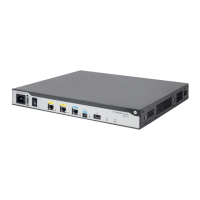423
Task Command
devices in standalone mode).
Display DRE statistics (distributed
devices in standalone mode/centralized
devices in IRF mode).
display waas statistics dre
[
peer-id
peer-id ] [
slot
slot-number ]
Display DRE statistics (distributed
devices in IRF mode).
display waas statistics dre
[
peer-id
peer-id ] [
chassis
chassis-number
slot
slot-number ]
Display the global WAAS status.
display
waas status
Display autodiscovered blacklist
information (centralized devices in
standalone mode).
display waas tfo auto-discovery blacklist
{
ipv4
|
ipv6
}
Display autodiscovered blacklist
information (distributed devices in
standalone mode/centralized devices in
IRF mode).
display waas tfo auto-discovery blacklist
{
ipv4
|
ipv6
} [
slot
slot-number ]
Display autodiscovered blacklist
information (distributed devices in IRF
mode).
display waas tfo auto-discovery blacklist
{
ipv4
|
ipv6
}
[
chassis
chassis-number
slot
slot-number ]
Clear the DRE data dictionary.
reset waas cache dre
[
peer-id
peer-id ]
Clear DRE statistics.
reset waas statistics dre
[
peer-id
peer-id ]
Clear all blacklist entries.
reset waas tfo auto-discovery blacklist
WAAS configuration examples
Predefined WAAS policy configuration example
Network requirements
As shown in Figure 153, apply the predefined WAAS policy on Router A and Router B.
The host downloads data from the server. Examine the optimization effect by comparing DRE
statistics for the first download and second download.
• For the first download, both WAAS devices need to create data dictionary entries and Router A
sends both indexes and metadata.
• For the second download, Router A replaces repeated data with indexes.

